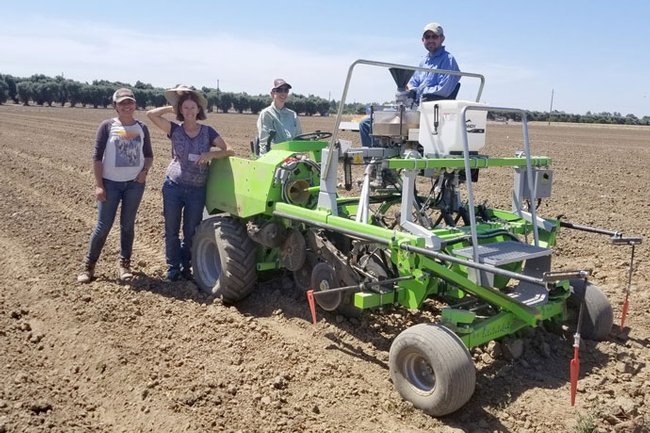- Author: Kathy Keatley Garvey

DAVIS--UC Cooperative Extension entomologist Larry Godfrey, a 26-year member of the UC Davis Department of Entomology and Nematology faculty and widely known for his research on applied insect ecology and integrated pest management (IPM) strategies, died April 18, succumbing to cancer. He was 60.
Dr. Godfrey was internationally acclaimed for his research on rice and cotton. He was heavily involved in developing IPM to maintain the sustainability of California agriculture, seeking “to reduce the ‘footprint' of agriculture on the environment and society, and to advance the science of entomology and applied insect ecology.”
At UC Davis, he taught arthropod pest management and agricultural entomology. He developed IPM strategies for not only rice and cotton but for such field and vegetable crops as alfalfa, dry beans, timothy grass, melons, mint and onions.
A member of the entomology department since April 1991, Dr. Godfrey served as its vice chair in 2008, and also that year, as president of the Pacific Branch, Entomological Society of America.
“Larry was an outstanding contributor to the department, not only as a researcher and teacher, but also in the effective ways that he connected with clientele through outreach,” said Steve Nadler, professor and chair of the UC Davis Department of Entomology and Nematology. “He was a member of our department's Executive Committee and I could always count on Larry for sound advice.”
“Being the two Davis faculty with agricultural entomology extension duties, Larry and I shared a lot over the last 25 years and he was my closest colleague in our department when he passed today,” said Extension entomologist and distinguished professor Frank Zalom, an IPM specialist and a past president of the Entomological Society of America. “I've always respected him for being quiet and humble despite his many accomplishments. He filled the shoes of several faculty members who retired before he came to Davis and he did his job exceptionally well. It's hard for me to imagine not having him nearby as the go-to entomologist for field crops, although his research, extension, and, most importantly his graduate students, will serve as his legacy for years to come.”
Said professor Jay Rosenheim: “Larry was a researcher who always placed the farmer's needs first. This is why he was so highly valued by California's growers of rice, alfalfa, cotton, and vegetable crops, and why his research program grew and grew over his years at Davis. He was also an excellent communicator, and epitomized the role of researcher/educator in the Land-Grant system. Despite his illness, he continued to work tirelessly on his pest management research, refusing to compromise on his commitments. His dedication to our profession was truly remarkable.”
Yolo County Farm Advisor Rachael Long, who collaborated with Dr. Godfrey on dry bean research, said: “He was an incredibly dedicated field crop entomologist and terrific colleague with team spirit, and his loss leaves a big hole in our lives and I'll miss him.”
“What I admired about Larry was his stoicism,” said former graduate student Mohammad-Amir Aghaee, now a postdoctoral fellow at North Carolina State University. “Nothing seemed to wear down his resolve.”
Dr. Godfrey, born July 7, 1956, grew up on an Indiana farm. He received two entomology degrees from Purdue University, West Layfayette: his bachelor's degree in 1978 and his master's degree in 1980. He earned his doctorate in entomology in 1984 from the University of Kentucky, Lexington, studying with major professor Kenneth Yeargan. He was a member of Phi Beta Kappa, Phi Kappa Phi, Sigma Xi and Gamma Sigma Delta.
Said Yeargan: "As I stated in my letter of recommendation for Larry many years ago when he applied for the position at UC Davis, Larry was an outstanding 'synthesizer' of information. He had a knack for looking at a problem, thinking through all the ramifications, and coming up with logical, practical ways to approach the problem – and usually finding a solution. He will be missed by many." It was at the University of Kentucky where Larry met his wife-to-be, Kris, then a postdoctoral scholar.
Dr. Godfrey began his career as a product development specialist for Union Carbide Agricultural Products Co., Inc., Research Triangle, N.C., before joining the University of Nebraska's Department of Entomology from July 1987 to March 1991 as a research associate.
“Growing up on a farm in Indiana, I saw first-hand the ‘battles' that farmers and homeowners face trying to produce crops and grow landscape plants in competition with insects,” Dr. Godfrey recalled in an earlier interview. “I became fascinated with insects through the typical ‘bug-in-a-jar' hobby. A county Natural Resources Field Day cultivated my interest in entomology and this led to enrollment in the 4-H entomology project. By the time I was several years into the 4-H project, I was transporting a dozen wooden collection boxes full of pinned insects to the county fair.”
“My first summer job involved surveying for Japanese beetles as they progressed across Indiana. This was an invasive insect in the Midwest in the mid-1970s; this same insect is of serious concern now in California an invasive pest that could damage many crops—such as grapes—and ornamentals—such as roses.”
Dr. Godfrey was one of 24 founding members of the California Invasive Species Advisory Committee, appointed by then Secretary A.G. Kawamura of the California Department of Food and Agriculture, to recommend “ways to mitigate non-native species' effects on resources throughout the state.” The goal: to protect California's environment, food systems, human health and economy from invasive and destructive pests, plants and diseases.
At UC Davis, Dr. Godfrey zeroed in on invasive insect and mite pests such as silverleaf whitefly, panicle rice mite, and rice water weevil. In addition, he targeted scores of pests, including alfalfa weevils, blue alfalfa aphids, spotted cucumber beetles, and two-spotted spider mites. He researched plant response to insect injury, refining economic thresholds.He also researched various pest management tactics, including biological control, reduced risk insecticides, mating disruption, cultural control, and host plant resistance.
Highly respected by his peers, Dr. Godfrey received the Excellence in IPM Award in 2005 from the Pacific Branch, Entomological Society of America (PBESA), followed by the PBESA Distinguished Achievement Award in Extension in 2010. Nationally, he was elected chair of ESA's Section F (crop protection) in 2002.
For many years, he served as the advisor to the UC Davis Linnaean Games teams, which won regional (PBESA) and national (ESA) championships in college-bowl type competitions involving insect questions. He himself was on the championship 1983 University of Kentucky team, the second annual Linnaean Games in the North Central Branch of ESA “where it all started,” he said. “It was a few years before the other branches started this competition and several years before they did it at the national meeting.”
As part of his Extension work, Dr. Godfrey wrote publications, regularly met with growers, and delivered scientific talks at workshops. He addressed the annual California Rice Field Day for 25 years and also spoke at alfalfa IPM workshops, among others. He was a subject editor for the Journal of Cotton Science and the Journal of Integrated Pest Management. In addition, Dr. Godfrey served on many departmental, college and UC Agriculture and Natural Resources committees.
Funeral services will be held Saturday, April 29 in Salem, Ind. In lieu of flowers, the family asks for donations to pet rescue groups or groups that support young people interested in entomology or agriculture.
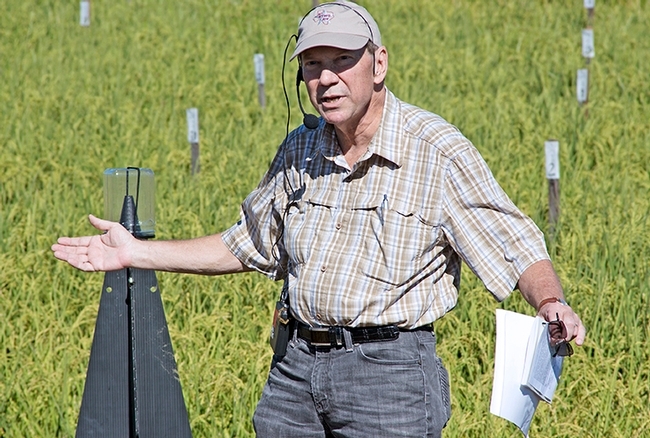
- Author: Rachael Freeman Long
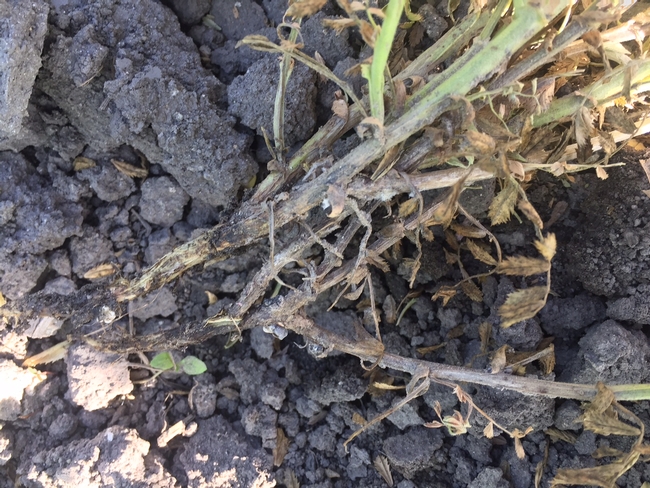
Our cool, wet conditions are favoring white mold (sclerotinia) in garbanzo beans this year. This disease is characterized by a white fungal growth that attacks the above ground plant parts, often near the soil line for garbanzos. The affected tissue dries quickly and bleaches to a pale tan or almost white color. Black sclerotia formed on the stem of dying plants are often visible. These are masses of fungi compacted to form small, dark pellets that range in size from 1-8 mm (about the tip of a pencil to a pencil-size eraser) that allow the fungus to survive in adverse conditions (e.g. hot, dry weather). When the main stem is affected near the soil line, the entire plant wilts and dies; lesser infections will show dead branches, causing yellow flagging in the field.
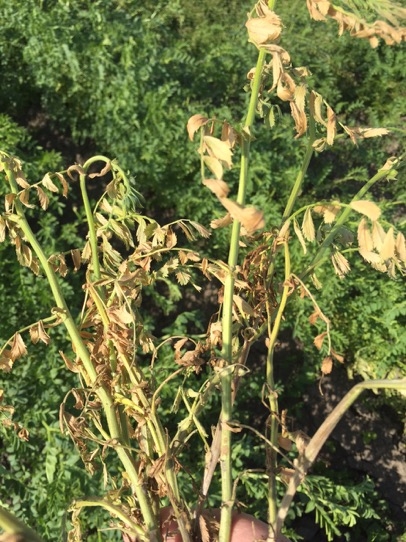
The black sclerotia pellets formed in the mold can survive many years in the soil and re-infect crops. The development of white mold is greatly influenced by prevailing weather conditions and certain agronomic practices such as late extensive irrigation, plant density, and plant growth characteristics, which are all closely linked with the life cycle of the pathogen. A thick dense plant growth provides a micro climate of cooler temperatures and high moisture beneath the plant canopy where conditions are favorable for disease.
The best control focuses on cultural practices to prevent the disease from developing in the field. This includes higher beds that keep lower plant parts and tops of the bed drier, wider row spacing to increase air movement in the canopy to keep the foliage drier, and planting garbanzo beans later (December through early February) rather than early (November) since the extra growing time can result in heavy canopies that increase humidity and cause infestations late winter/early spring (favorable disease conditions, 68oF-77oF). Crop rotation generally does not prevent white mold infection due to the broad host range of the pathogen.
Fungicides are available for white mold control, but getting good coverage and control is difficult because the inoculum is in the soil and the disease is often deep in the plant canopy. Fungicides would have to be applied when plants are smaller to provide good coverage and protection from this disease. For a list of fungicides available for white mold control in in garbanzos, see http://ipm.ucanr.edu/PMG/r52100111.html.
- Author: Michelle Leinfelder-Miles
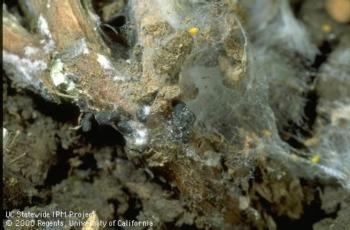
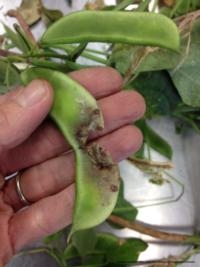
I later visited the field with the PCA in order to assess the situation for myself. The disease appeared to be most apparent in one corner of the field where the water tends to sit a little longer. (This is a furrow irrigated field that has had beans for several consecutive years.) Moist or humid conditions favor white mold, as do heavy canopies. The leaves were showing some unusual brown lesions, and some plants had white mycelium growing on the pods (Figure 2). The most detrimental symptom that we observed, however, was complete infection of the stem at the soil line, causing the tissue to dry up (Figure 3). In this case, the upper canopy looked ok, but I am uncertain, perhaps doubtful that the pods will fill on these plants.
What we can hope is that the disease won't appear on more plants in the next two weeks because there are really no management strategies at this stage in the game. The grower needs to think about how to manage this disease in the future, and rotating out of beans to a non-host crop (like small grains or corn) is probably a good strategy.
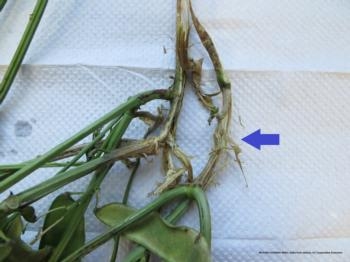
If wider row spacing is an option, this can also improve air movement in the canopy, which makes conditions less favorable for white mold. Monitoring for the disease should begin at flowering, which is also the best time to apply fungicides (like thiophanate methyl or boscalid) because the plants are small enough for the treatment to penetrate into the canopy.
- Author: Michelle M Leinfelder

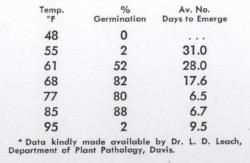
In addition to the production manuals previously mentioned, I also consulted UC production manuals produced in the 1950's, including Dry Edible Bean Production in California (1954), Blackeyes: Costs of Production, Suggestions on Growing (1956), and Production of Dry Edible Lima Beans in California (~1951).

